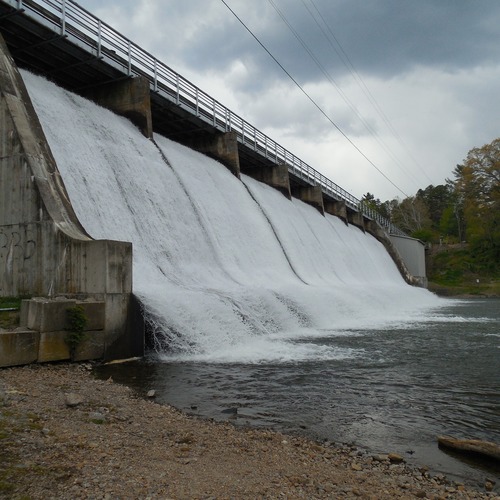
After enduring eight years of Republican Governor Paul LePage, renewable energy advocates are breathing a sigh of relief as his Democratic successor settles into office.
The state is deeply divided over a 145-mile power line that would slice through Maine’s pristine northern forests to deliver hydro power from Quebec to users in Massachusetts. But Governor Janet Mills, who took office in January, is helping to reverse the chilly reception given wind and solar energy by LePage and has pledged to push Maine toward 100% renewable energy by mid-century.
Mills has lifted a moratorium on the development of wind energy that her predecessor had put in place. And in a sharp change of tone, Mills says she wants solar panels installed on the roof of the governor’s official residence in Augusta.
She’s also scheduled to sign legislation on April 2 that will restore net metering for homeowners with photovoltaic arrays while junking a system called “gross metering” that was unpopular with solar advocates and installers.
“Maine’s solar industry can finally breathe again now that Governor Janet Mills and the new legislature have restored the proverbial oxygen of net metering for all residential and commercial solar projects,” Phil Coupe, co-founder of Portland-based ReVision Energy, said in an email.
Coupe continued: “Mainers are already responding to the positive encouragement coming from state political leadership by signing contracts for solar and other clean energy technologies at a pace we have not seen in the previous eight years.”
Maine is the region’s wind leader with more than 900 MW of installed capacity, double what the rest of the New England states have combined, according to the American Wind Energy Association.
But the LePage years were tough on renewable energy policy. The Natural Resources Council of Maine called his opposition to solar energy a “crusade.” Wind fared little better. With a substantial offshore wind potential in the Gulf of Maine, the state attracted the interest of Norway’s Statoil, which won initial state approval for 20-year contract for four wind turbines 12 miles off the coast. But after LePage reopened the competitive bidding process in 2013, the Norwegians pulled out of the $120 million project.
That was just the start of the then-governor’s adversarial relationship with the wind and solar industries. Later, LePage endorsed offshore oil drilling in the Gulf of Maine and ordered a moratorium on new wind energy projects. The ban proved mostly toothless, but it cast a shadow over new wind development.
LePage also appointed a committee to study the impact of wind energy on the state’s important tourism industry. But he kept its members secret and said the panel would not be subject to the state’s open-meeting laws.
All of that is now in Maine’s rear-view mirror.
Power line is still on the table
Governor Mills’ embrace of renewable energy is a breath of fresh air to renewable energy advocates, but the proposed power line, worth nearly $1 billion, is turning out to be the most divisive environmental issue in recent memory.
The New England Clean Energy Connect would send power from Hydro-Québec to Massachusetts through a transmission corridor to be built by Central Maine Power. The issue is still before the Public Utilities Commission, but Mills says she supports a negotiated settlement between business, labor, and environmental groups that would allow the project to go forward. The PUC staff also has signed onto the deal, further strengthening its odds in the upcoming vote by PUC commissioners.
The project would still require environmental permits before construction could start. Avangrid, CMP’s corporate parent, has pledged to spend $258 million over 40 years for a variety of Maine energy and community programs in exchange for permission to build the transmission line. It’s a big step up from the utility’s initial offer, but critics say that isn’t enough.
None of the power would be used in Maine, a fact that has rallied critics. Opponents say the project would ruin a swath of pristine northern forest, and claimed the new line would not reduce carbon pollution in the region, The Portland Press Herald has reported.
The project would require about 53 miles of new transmission lines in the state’s undeveloped North Woods, and expand another 92 miles of existing power lines, according to the Natural Resources Council of Maine. The environmental group says the line would cross the Appalachian Trail, 262 wetlands, 115 streams, and inland bird habitat.
“Despite these significant environmental impacts, CMP has been unable to demonstrate that this transmission line would provide any environmental benefits, such as reduced greenhouse gas emissions,” the group says in a statement posted at its website.
Mills, on the other hand, says the state “cannot afford to do nothing” about its heavy reliance on fossil fuels for heat and the threat of climate change.
“Importantly, the discussions in recent weeks have brought to the table the largest generator of renewable energy in North America — Hydro-Québec,” Mills said in a statement last month. “Partnering with this provincial company to our north, with its plentiful low carbon generation, along with local renewable generators, will not only bring down the price of power for consumers of all sizes but will also help us wean off of fossil fuels in a significant way.
“This project, if further permitted,” the statement continued, “will put our state and our region on the road to a zero carbon economy by 2050.”
Ad campaign is a point of contention
One point of contention is an ad campaign criticizing the proposed transmission line. It accuses Mills of making a “backroom deal” with CMP and says she changed her mind on the project only after she was elected last fall.
“CMP’s corridor would cut a path as wide as the New Jersey Turnpike through our Maine woods,” the ad says, “just so Canada can sell power to Massachusetts.” It shows Mills against a backdrop of construction equipment, raw earth, and utility towers.
A group called Stop the Corridor has sponsored the ad, according to The Press Herald. Its members include the Natural Resources of Maine, the Maine Renewable Energy Association, and ReEnergy Holdings, a New York-based biomass energy company that got $4 million in Maine subsidies in February. But none of those groups admits to paying for the spot.
Riley Ploch, a spokesman for Stop the Corridor, wouldn’t discuss the issue.
The claim that the corridor would “cut a path as wide as the New Jersey Turnpike” is startling but ultimately misleading, according to a report posted at WGME, a local CBS affiliate. The New Jersey Turnpike Authority says the turnpike is between 300 feet and 350 feet wide. While the 53 miles of new corridor would be 300 feet wide, only half of it would be cleared of trees and vegetation, according to CMP.
Even so, the ad may be undercutting public support for the project. The line would run through the Farmington, Janet Mills’ hometown, where town officials in 2017 had signed a letter supporting the project. But late last month, town residents packed the community center and voted 262-102 to rescinded the letter, The Bangor Daily News reported. Both Mills and CMP spokesman John Carroll were in attendance.
A nearly hour-long debate preceded the vote. John Bubier, a local business owner, said the transmission line would be “like a knife cutting through our community. You’ll be able to see the towers from downtown.”
Franklin County commissioners also have reversed an earlier vote of support for the project.
Legislation on other fronts
While plans for CMP’s new transmission line move forward, the state representative who was the chief sponsor of legislation restoring net metering sees other advances on the way for renewable energy policy.
State Representative Seth Berry, a Democrat, told Utility Dive that other bills will increase Maine’s renewable portfolio standard and advance offshore wind. There also is some support for the possible purchase of the state’s two investor owned utilities, including Central Maine Power, and a transfer of those assets to a publicly owned utility.
Berry has proposed that a new agency called the Maine Power Delivery Authority assume the assets of both CMP and Emera Maine, a smaller electric utility serving the northern part of the state. The authority would use low-interest revenue bonds to make the purchase and, Berry hopes, lower costs for Maine consumers.
“Maine people want and deserve a utility that will keep the costs down and the lights on and put its Maine customers and workers first,” Berry, the co-chairman of the Legislature’s Energy, Utilities and Technology Committee, told the Press Herald. “Our current utilities have failed us in every respect, with the clear exception of our own consumer-owned utilities.”
Vaughan Woodruff, president of Insource Renewables, a solar installer, told Utility Dive that getting the legislation passed would be a “heavy lift.”
“If that bill passes and we forced the sale of the investor owned utilities in the state of Maine, it would be one of the most shocking things to see in a single legislative session in Augusta, related to energy, that I’ve seen in my time there,” he said.
Weekly Newsletter
Get building science and energy efficiency advice, plus special offers, in your inbox.














0 Comments
Log in or create an account to post a comment.
Sign up Log in